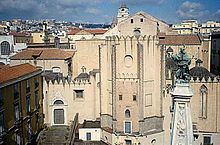San Domenico Maggiore
| Church of San Domenico Maggiore | |
|---|---|
| Chiesa di San Domenico Maggiore | |

The Church of San Domenico Maggiore in Naples (apse area).
|
|
| Coordinates: 40°50′55″N 14°15′16″E / 40.848731°N 14.254407°E | |
| Location | Piazza San Domenico Maggiore Naples Province of Naples, Campania |
| Country | Italy |
| Denomination | Roman Catholic |
| Architecture | |
| Status | Active |
| Architectural type | Gothic architecture, Baroque architecture |
| Groundbreaking | 1283 |
| Completed | 1324 |
| Administration | |
| Diocese | Roman Catholic Archdiocese of Naples |
San Domenico Maggiore is a church in Naples, southern Italy, founded by the friars of the Dominican Order, located in the square with the same name. The square is bordered by a street/alleyway popularly called "Spaccanapoli" (presently labeled via Benedetto Croce at this particular section of its considerable length) in the historic center of Naples. It was one of the three main east-west streets of the original Greek city of Neapolis. To the east along Spaccanapoli, one reaches in a few blocks the Piazza of Gesu Nuovo and Santa Chiara.
In the center of the square is an obelisk— one of three "plague columns" in Naples—topped by a statue of Saint Dominic, founder of the Dominican Order, erected after the plague of 1656. The original designer of the spire was the Neapolitan architect Cosimo Fanzago. Construction on the spire was started after the plague of 1656 and was finally finished in 1737 under Charles III, the first Bourbon monarch of Naples.
The Church of San Domenico Maggiore incorporates a smaller, original church built on this site in the 10th century, San Michele Arcangelo a Morfisa.
Charles II of Naples began the rebuilding that produced the new Church of San Domenico Maggiore. The work was done between 1283 and 1324, but the church has undergone modifications over the centuries, including one in 1670 that recast the structure in the style of the Baroque. In the 19th century, however, the church was restored to its original Gothic design.
The monastery annexed to the church has been the home of prominent names in the history of religion and philosophy. It was the original seat of the University of Naples, where Thomas Aquinas, a former member of the Dominican community there, returned to teach theology in 1272. After Matins on December 6, 1273 Aquinas lingered in the Chapel of Saint Nicholas and was seen by the sacristan Domenic of Caserta to be levitating in prayer with tears before an icon of the crucified Christ. Christ said to Thomas, "You have written well of me, Thomas. What reward would you have for your labor?" Thomas responded, "Nothing but you Lord."
...
Wikipedia
